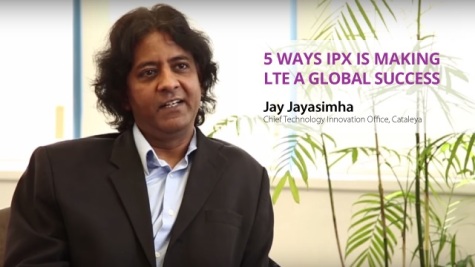Exclusive interview with Paul Gowans, Mobility Marketing Manager at Viavi

Paul Gowans, Mobility Marketing Manager at Viavi
Viavi Solutions (formerly JDSU, Arieso and Network Instruments) is very active in LTE and helping to advance the technology … how has LTE progressed since last year?
LTE as a standard continues to evolve to meet the growing capacity and coverage demands of mobile consumers. With LTE Advanced and LTE Broadcast being two examples. Yet it is the area of VoLTE which has probably seen the greatest change from last year. At the event last year many operators were planning their VoLTE roll-out and engaging their technology partners such as Viavi on the challenges to address and ensure they deliver on the high expectations of VoLTE. Now, we have many operators who have either deployed or are very close to deploying. There is also the area of the relevance of voice today – many people of course have an iPhone or other Smartphone and use a multitude of methods to communicate – certain generations don’t talk at all! So, the industry has had to appreciate that VoLTE needs to be integrated into the way people communicate today.
What are the top VoLTE challenges?
Working closely with our mobile operator customers and building on our experience with IP based voice services as well as RAN and Core network challenges I would say the top three challenges are:
- Voice Quality – measuring end-to-end (E2E) voice quality is fundamental to understanding the customers quality of experience (QoE). Knowing what metrics are important, where to measure and quickly finding the root cause of voice quality affecting issues.
- Handovers – when you move out of an LTE service area and have an active VoLTE call, the user will want to continue with that call. SRVCC seamlessly maintains calls when a mobile user moves from LTE to non-LTE coverage areas. Of course, there is the potential for things to go wrong and calls to get dropped. Also, if the user is not supporting VoLTE but is using LTE, when they receive a call the phone the network need to fall back (CSFB) so that both data and voice are non-LTE.
- Location – not only knowing what service is being provided to the consumer but also from where so that you can determine, for example, VoLTE hot spots – that is where there may be too many dropped calls or handovers have failed. By accurately geo-locating voice quality metrics you can make better business decisions on service delivery.
Presentation theme/message at the event?
In addition to introducing Viavi Solutions to the audience, Viavi will be presenting in 3 key areas, namely: VoLTE, HetNets and Network Optimization. The theme of the VoLTE presentation is how to address some of the key VoLTE challenges and ensure the subscribers gets an exceptional VoLTE service. We will be exploring voice quality- passive measuring, active measuring – how integrating handset data with core data and then geo-locate that information to maximize the business impact of the service. The E2E view of the service from device to RAN to backhaul and core. For HetNets we will be discussing workforce automation and how to ensure cell site turn up to be most cost-effective without impacting quality. Network Optimization will build on the extreme non-uniformity in cellular networks and how subscriber-based, location-aware predictive optimization is needed.
Meet Paul and the Viavi team at the upcoming LTE North America, in Dallas, next November 17th-19th!





 CSPs are under constant pressure to be proactive all the time, since they need to stay ahead of the competition and are facing challenges on a daily base. But first and foremost, they need to keep their subscribers happy – not an easy task!
CSPs are under constant pressure to be proactive all the time, since they need to stay ahead of the competition and are facing challenges on a daily base. But first and foremost, they need to keep their subscribers happy – not an easy task!








 one to carrier RF design specifications for azimuth, mechanical tilt and roll. Some before/after audits have shown that as many as 40% of antennas are installed more than five degrees off target. Using this audit data, simulations are possible with RF network propagation software and any market final design project. These results will prove that even when using conservative misalignment changes that induced network interference can be costly to carriers specifically for newer interference prone LTE technologies. Focusing just on carrier spectrum capital investment this number can easily become surprisingly high when considering large nationwide RF spectrum investments. The cost of ‘wasted’ spectrum due to interference does not, but could consider additional costs of ‘unused’ BTS/RAN infrastructure, unnecessary network performance troubleshooting efforts, less the credible output from RF propagation, ACP and SON tools , and more important, the effects of poor customer data experiences -all caused by misaligned RF antennas.
one to carrier RF design specifications for azimuth, mechanical tilt and roll. Some before/after audits have shown that as many as 40% of antennas are installed more than five degrees off target. Using this audit data, simulations are possible with RF network propagation software and any market final design project. These results will prove that even when using conservative misalignment changes that induced network interference can be costly to carriers specifically for newer interference prone LTE technologies. Focusing just on carrier spectrum capital investment this number can easily become surprisingly high when considering large nationwide RF spectrum investments. The cost of ‘wasted’ spectrum due to interference does not, but could consider additional costs of ‘unused’ BTS/RAN infrastructure, unnecessary network performance troubleshooting efforts, less the credible output from RF propagation, ACP and SON tools , and more important, the effects of poor customer data experiences -all caused by misaligned RF antennas.


